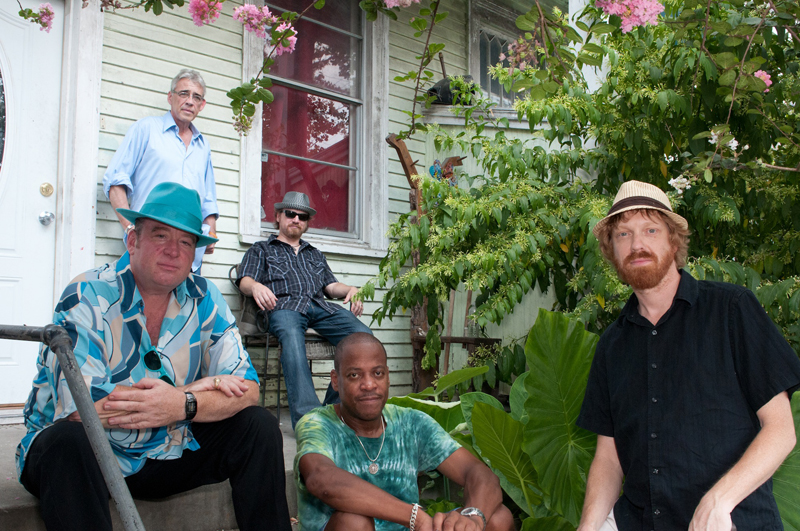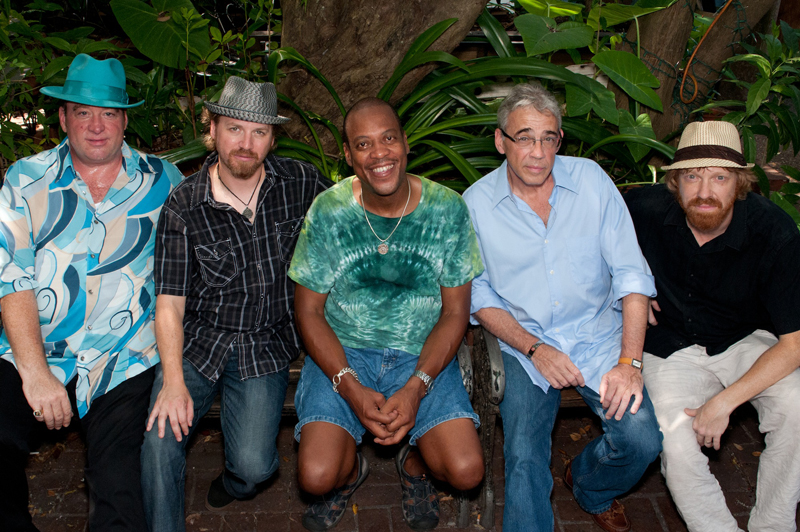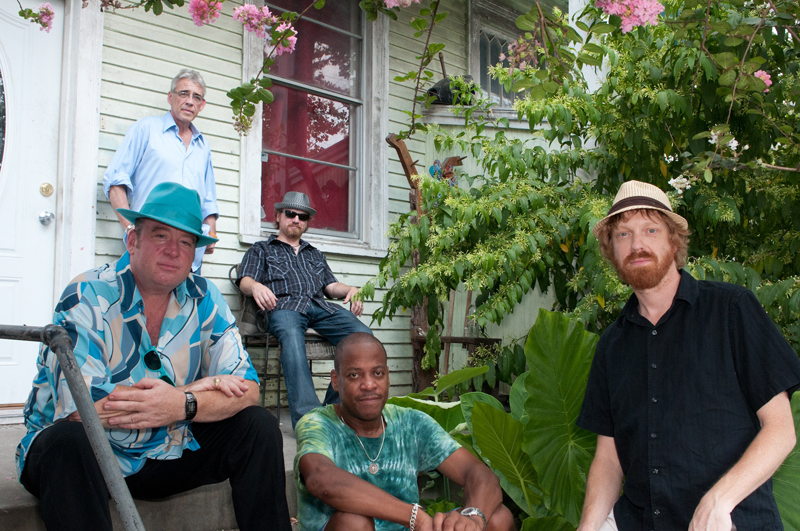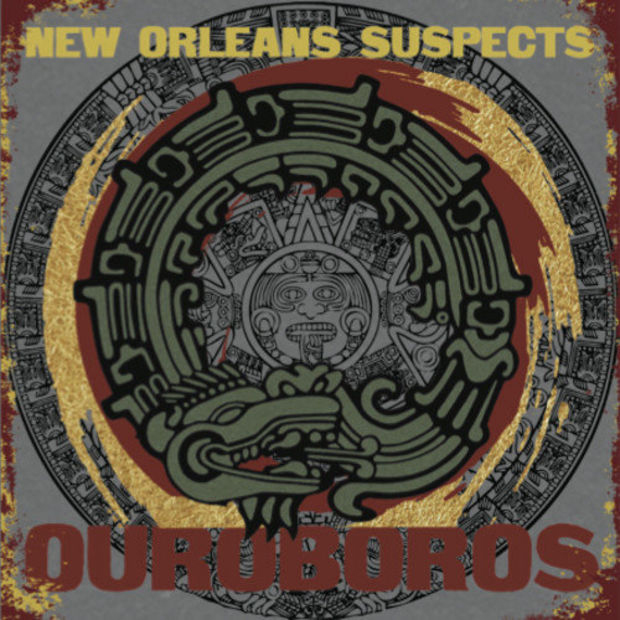'Ouroboros': The New Orleans Suspects’ Funkified Masterpiece

You could apply the term “supergroup” to the New Orleans Suspects, and it wouldn't be hyperbole. These cats have been there, done that and have the chops to prove it.
Saxophonist Jeff Watkins’ career includes a dozen years leading James Brown’s band; Willie Green drummed for the Neville Brothers for more than three decades; CR Gruver has played keys with Outformation and Leo Nocentelli; guitarist Jake Eckert laid it down funky for years with the Dirty Dozen Brass Band; and Reggie Scanlan’s bass provided the low-end wump for New Orleans’ beloved Radiators.
Dig deeper and you’ll find all of these players are multi-genre monsters, with histories that span the gamut from jazz to jam.
Ouroboros is the New Orleans Suspects’ third album and is the best example yet of what the band is capable of. Co-produced by Eckert and Watkins, Ouroboros offers up big grooves and big pictures, heavily flavored with N’awlins magic and hoodoo.
In the following conversations Reggie Scanlan and Jake Eckert share a few behind-the-scenes secrets about some of the ingredients of that magic and hoodoo. (You might be surprised …)
Reggie Scanlan: Keeping It Pure — and Stealing from the Greats
GUITAR WORLD: Reggie, you cover an amazing amount of rhythmic and sonic ground on Ouroboros. What were you running for gear? SCANLAN: I wanted to keep the bass sound very consistent from song to song because the songs themselves were going to change so much. I basically stuck with one of my stage basses, which is an 8- or 10-year-old Fender Jazz bass. And I ran that through a SansAmp in the studio.Tell me about the SansAmp. I’ve heard of them but don't know much about them.It’s the best piece of gear I’ve bought, next to my bass and my Hartke cabinets, which never seem to go bad after ages. Jeff Watkins, our sax player, turned me onto the SansAmp: it’s basically a direct box that you have controls on—volume, presence, treble, bass—and you can send your signal out the way you want it. In the studio, we ran everything through the SansAmp and Jeff did his magic to make it sound killing.The track “Hoodoos and Cunyans” is an absolute full-length feature movie in your head, and part of that vibe is what sounds to me like a big old upright bass.Yeah! [laughs] I used my Juzek upright bass, which was made in Germany back in … 1922? … somewhere around there. It has gut strings with no pickups or anything. Totally acoustic and sounds great when you mic it. It’s just beautiful.I know you’ve told me before about how much you enjoy playing acoustic bass. You’ve mentioned the jazz guys who were your heroes: Mingus … Paul Chambers …Oh man, Paul Chambers. You know, it almost didn't matter what he played because his tone was so good. It was like there weren’t any bad notes. It was just this beautiful tone, pushing and pulling through the music. It was great. If I was trying to describe your bass voice to someone, I’d say you can get as out there and funky as anyone, but you’re never far away from your jazz roots. It’s the same basic broth anyway …Yeah, that’s right. I mean, I steal a lot from those jazz guys. It's a good place to go to build up a library of things you can fall back on in jams and stuff.Something happens and you’re feeling it, but you don't know what it is … and all of a sudden you’ve got this old bass riff that Paul Chambers did as a solo and it’s the perfect thing to drop in. Nobody knows where it came from, unless they're really paying attention. [laughter] I love taking something out of one genre and putting it in another, you know? To me, that’s the fun of playing music.That’s one of the major lessons I learned years ago from James Booker: all of this stuff is the same.Everybody’s got the same bunch of notes to work with, whether it's classical or you’re doing street music. It’s what made it possible for us to be playing “Iko Iko” or something like that, and all of a sudden Booker’s piano solo would turn into a Chopin piece. And it would make sense; everything would be cool … I wouldn’t know what was happening [laughter], but to him, everything was everything. That was a major lesson: it’s all just music and everybody’s fooling with the same notes. You just mix them up differently.That’s a great approach for anyone. I don't care if it's a kid just getting going or somebody who’s been in it a while and their attitude’s taking a bad turn: don't worry about labeling stuff, just play.Yeah! Just play, and play something that feels good, you know? If it feels good, it's probably the right thing to play. It's like everything else in life. You have as much freedom as you want, as long as you don't step on the next guy’s freedom. With music, you should play what you feel, as long as you’re not stepping on the next guy or playing all over them, getting in their tonal space.
Jake Eckert: “It’s Not the Kitchen — It’s the Cook”GUITAR WORLD: Jake, you’re cranking out a lot of great playing on this album: from kick-ass funk grooves and nasty leads to some wickedly hot slide work. What were your weapons for the Ouroboros sessions?ECKERT: My main guitar is the ES-335 Gibson I’ve played for years, through the Dirty Dozen and now with the Suspects. It’s kind of been my baby. I have other 335 guitars, but that’s my main one. It’s been through the wringer: I’ve had the neck broken off on the road three times over the years. [laughter]What year is it?It’s a Dot Neck reissue from the early 2000s. I don't know exactly what year. It’s all stock; nothing fancy, but it sounds great and I love the way it plays.I also use a 1979 Strat with Pearly Gates pickups and a new PRS Starla with a Bigsby on it.You know, I’ve heard of those, but I’ve never sat down with one. A PRS with a Bigsby …I know: it’s kind of an oxymoron, right? [laughter] If you listen to “Walk Of Shame,” there’s this one little part where it goes to the minor on the bridge and you hear me wiggle the Bigsby … it really does sound like an old pawnshop guitar.How about for slide? The stuff you do on “Madgalena,” for instance.That’s my Gibson SG, a 1991 I’ve had since then. I traded a 1974 Goldtop for it.Ooh …Yeah, well … somebody chopped out the original humbuckers on the Les Paul and put some other ones in with a screwdriver. [laughter] I used the SG plugged directly into my Ampeg Reverb Rocket, turned all the way up. It's a great sound.I also have an ’89 Strat Plus with a Jeff Beck pickup in the rear position that I use for slide sometimes. You pull some wildass bends at times during your leads, but you run fairly heavy strings, don't you?Yeah, D’Addario EXL115s, 11 to 49. I use them for slide and regular-tuning stuff. I was using 10s for a while and switching back and forth, but I kind of grew into the feeling of the 11-gauge strings and noticed the tone was just a little bit beefier. Now I enjoy the feeling when they fight back just a hair.You mentioned the Ampeg Reverb Rocket; what else did you use for amps?Actually, I endorse the Mega Boogies and I used my Lone Star a lot … most of the cleaner stuff you hear is the Mesa. And along with the Ampeg, sometimes I use a 1964 Super Reverb.Effect pedals?I use Mesa Boogie pedals: a Grid Slammer overdrive and a Tone-Burst boost. They’re really great. They have that Mesa vibe to them. I also have an Xotic AC booster and an RC booster. You know, the pedals are all cool, but … I was able to record a song with Larry Carlton one time and he was using that same Ampeg Reverb Rocket I mentioned. Larry plugged into the amp and that was it, no pedals; no nothing. He started soloing … and he sounded just like Larry Carlton. That’s when I realized it's not the kitchen, it's the cook. [laughter]There’s some story I’ve heard for years about Jeff Beck walking into some hole-in-the-wall guitar shop. He grabbed a totally shitbox guitar off the wall, plugged into a little amp on the floor, and let it rip. No doubt about it: it was Jeff Beck playing. Yeah! I remember the Little Feat guys telling about Eric Clapton showing up for one of their gigs—this was post-Lowell George—and I think they had some really beat-up Dean Markley amp up there or something. It was all they had, that and an extra guitar. They said Clapton walked out, fiddled with the amp for a second and started playing.He just sounded like Eric Clapton. [laughter]Photo: Jeffrey DupuisA former offshore lobsterman, Brian Robbins had to wait a good four decades or so to write about the stuff he wanted to when he was 15. Today he’s a freelance scribe, cartoonist, photographer and musician. His home on the worldwide inner tube is at brian-robbins.com (And there’s that Facebook thing too.)
Get The Pick Newsletter
All the latest guitar news, interviews, lessons, reviews, deals and more, direct to your inbox!




“There’d been three-minute solos, which were just ridiculous – and knackering to play live!” Stoner-doom merchants Sergeant Thunderhoof may have toned down the self-indulgence, but their 10-minute epics still get medieval on your eardrums
“There’s a slight latency in there. You can’t be super-accurate”: Yngwie Malmsteen names the guitar picks that don’t work for shred

![A black-and-white action shot of Sergeant Thunderhoof perform live: [from left] Mark Sayer, Dan Flitcroft, Jim Camp and Josh Gallop](https://cdn.mos.cms.futurecdn.net/am3UhJbsxAE239XRRZ8zC8.jpg)







